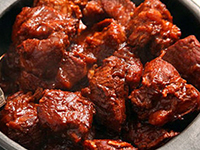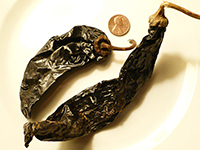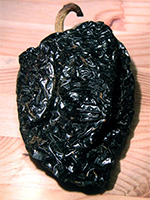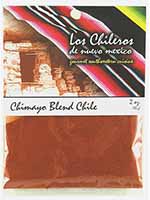 |
New Mexican-Style Carne Adovada (Braised pork with New Mexican chile peppers) |
This is a fairly simple and quick dish, consisting of pork braised in a sauce made of puréed chile peppers, spices, vinegar and honey. The name derives form the Spanish word "Adobo" or "Adobar" (Spanish for marinade, sauce, or seasoning), which means the immersion of raw food in sauce made of paprika, oregano, salt, garlic, and vinegar to preserve and enhance its flavor. The practice is native to the Iberian Peninsula (Spanish and Portuguese cuisine). With the conquest of the New World, it was widely adopted in Latin America and other Spanish and Portuguese colonies, including the American Southwest, but also Azores, Madeira and the Philippines.
 Chipotle chiles in Adobo sauce. |
This New Mexico-style recipe brings in local flavor of the American Southwest through the use of authentic New Mexican chile peppers. These have a distint flavor combining spiciness with sweetness and richness. The spiciness is not overdone, the heat is not unbearable as it could in some Asian or Indian dishes. New Mexico chile peppers have a "friendly" heat laced with sweetness.
Various forms of dried chile peppers can be used for this recipe. Their choice will be determined by what you can find at your local store. Obviously, genuine New Mexico products would be best in order to get the most authentic flavor. But if you live in the middle of Yorkshire, in a valley in Tyrol, or in a small Czech village, you may find it rather difficult to buy at your local supermarket organic ground chile powder from Chimayo, New Mexico. Substitutions can certainly be made, but Hungarian hot peppers or Italian peperoncini do not have the same flavor, and Asian chile peppers tend to be too hot. New Mexican chile peppers combine spiciness with sweetness and richness that is difficult to duplicate. Moreover, chile powder sold in mainstream supermarkets is very often a laced with additional ingredients such as garlic powder, cumin or oregano. So, do go the extra mile mile and try to obtain good ingredients. Authentic ingredients can be mail-ordered from the web from vendors such as "Los Chileros de Nuevo Mexico" or the "Potrero Trading Post", and delivered anywhere in the world.
 Pasilla chile. |
 Ancho chile. |
Pasilla chiles are used especially in sauces. They are often combined with fruits and are excellent served with duck, seafood, lamb, mushrooms, garlic, fennel, honey, or oregano. They are sold whole or powdered. Pasilla de Oaxaca is a variety of smoked pasilla chile from the Mexican state of Oaxaca used in mole negro.
 Chimayo chile. |
 Chimayo chile powder. |
Chile chipotle is a smoke-dried jalapeño. The name comes from the Aztec word "chilpoctli" ("smoked chili"). It is sold in cans, preserved in dark red, piquant sauce made from ground chiles, herbs and vinegar.
 Chile Caribe (ground New Mexican chile pepper flakes). |
All of these peppers belong to the species Capsicum annuum native to southern North America and northern South America. The species includes the fiery cayenne, jalapeños and serranos, the entire range of varieties of the New Mexico chile pepper, and mild bell peppers and poblanos.
If you desire a deeper discourse into the world of New Mexican and Mexican chile peppers, read our essay on French and Spanish cuisine in the Americas.
Ingredients:
- 3 1/2 lbs pork loin, cut in bite-size cubes
- 1/3 cup vegetable oil
- 2 tsp chile caribe (crushed red New Mexico chile flakes)
- 3/4 cup Chimayo red chile powder, mild or medium-hot (substitute any red New Mexico
chile powder, do not substitute Indian or Chinese chile powder as the flavor
is not the same)
- Or:
- 4 whole dried ancho chiles, seeds and stems removed
- 4 whole dried pasilla chiles, seeds and stems removed
- Can of 3 whole chipotle chiles in adobo sauce
- 2 cups onion, diced
- 2 tbsp garlic, minced
- 4 cups chicken broth or water
- 2 tsp coriander seed, ground
- 1 tbsp ground cumin
- 2 tsp dried Mexican oregano
- 3 bayleaves
- 1 tbsp honey
- 2 tbsp sherry vinegar or red wine vinegar
- salt to taste
- Corn tortillas, cilantro, diced onions, lime wedges, and queso fresco for serving (optional)
Preparation:
- Heat the oil in a large skillet and brown pork in batches, set aside.
- Add the onion to the skillet and sauté until golden. Add the garlic and sauté for 1 minute. Deglaze the skillet with 1 cup of the chicken broth.
- Using a food processor or a blender, purée the cooked onions and garlic, coriander, cumin, oregano, all the chiles, honey, vinegar, salt, and the deglazing liquid from the skillet plus 2 more cups of chicken broth. Process until the mixture is thoroughly combined.
- Or: if using chile pods, toast them in a dry frying pan over medium-high heat, stirring frequently, until intense roasted aroma is released, 2 to 5 minutes. Place in a food processor or a blender, add the cooked onions and garlic, coriander, cumin, oregano, all the chiles, honey, vinegar, salt, and the deglazing liquid from the skillet plus 2 more cups of chicken broth. Purée until the mixture is thoroughly combined.
- Place the browned meat, the contents of the blender, plus the remaining 1 cup chicken broth in an ovenproof pot or dish, stir well, and cook for 1 hour.
- YIELD: Serves 8

back to Radim and Lisa's Well-Travelled Cookbook | email us
Last updated: July 30, 2016